Lyocell is an eco-friendly fabric from wood pulp, offering sustainability and versatility, increasingly popular in the fashion industry for its environmentally responsible production.
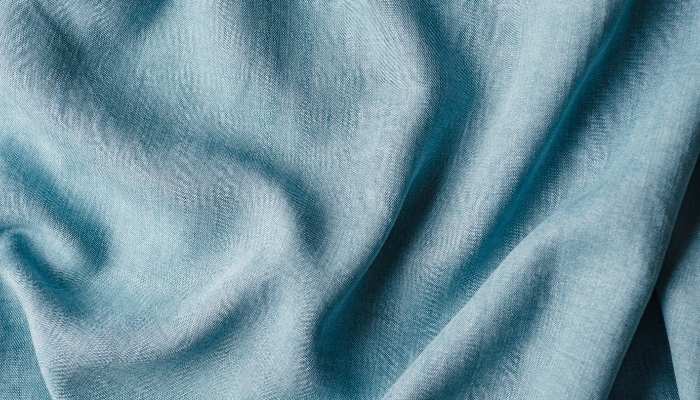
Key Takeaways
| Aspect | Details |
|---|---|
| Origin & History | Developed in 1970s, North Carolina; known as “Newcell,” then “Tencel” in 1980s UK. |
| Production Process | Uses sustainable tree sources like eucalyptus; employs organic solvents in environmentally friendly process. |
| Solvent Spinning & Closed-Loop System | Non-toxic process recycling 99% of solvents; minimal waste and water usage. |
| Unique Benefits | Blends with other fabrics; superior moisture absorption, breathability, durability; skin-friendly, biodegradable. |
| Comparisons | More sustainable, durable than viscose rayon, modal rayon, polyester, and cotton. |
| Applications | Used in fashion (dresses, underwear, shirts), industry (conveyor belts), medical field (wound dressing), eco-friendly papers. |
| Environmental Impact | Closed-loop production minimizes emissions, biodegradable fabric, sustainable tree farming. |
| Care Instructions | Prefer handwashing, air dry; gentle machine wash and iron on warm setting if necessary. |
This article will dive deep into the world of Lyocell, shedding light on its significance in today’s eco-conscious fashion eco-system.
Exploring Lyocell Fabric
1. The Origin and History of Lyocell
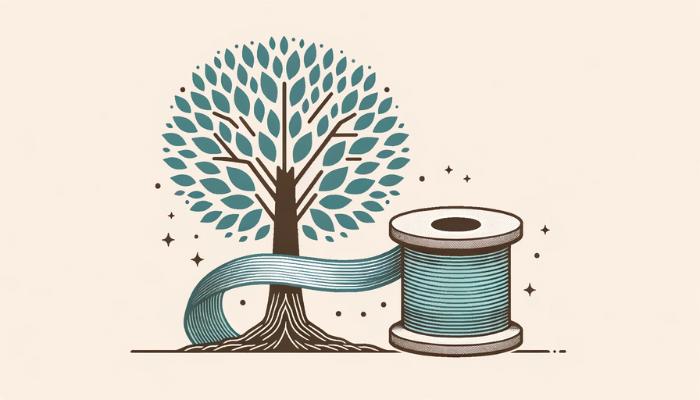
The 1970s were not just about disco and bell-bottoms. In 1972, amidst the vibrant backdrop of this era, Lyocell was born. Initially developed at the American Enka fibers facility in North Carolina, this innovative fabric was a game-changer. Recognized for its groundbreaking nature, the American Association of Textile Chemists and Colorists honored the creation with accolades.
But what’s in a name? Quite a lot, as it turns out. While undergoing its developmental stages, Lyocell was known as “Newcell.” However, as the 1980s rolled in, Courtaulds Fibres in Coventry, UK, took the baton and further refined the fabric, christening it “Tencel.” This name would soon become synonymous with sustainable fashion, marking a significant transition in the textile industry.
2. Production Process of Lyocell
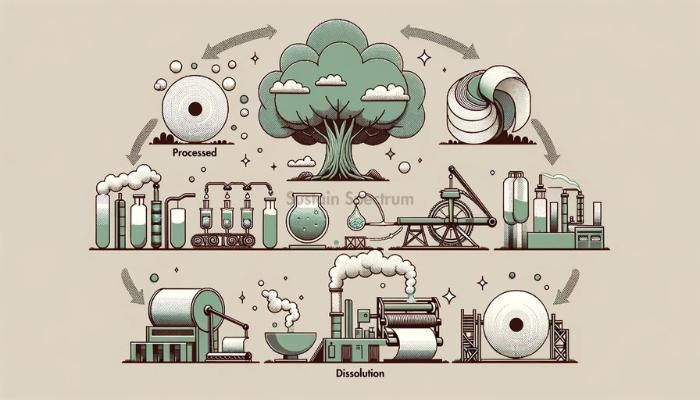
The production of Lyocell is a fascinating blend of nature and technology. Let’s delve into how this eco-friendly fabric comes to life and how it stands apart from its counterparts like rayon.
Rayon vs. Lyocell: A Quick Comparison
Origin:
| Rayon | Lyocell |
| Derived from cellulose, often from wood pulp. | Also derived from cellulose, but primarily from sustainable tree sources like eucalyptus, spruce, and beech. |
Chemicals Used:
| Rayon | Lyocell |
| Uses hazardous chemicals like carbon disulfide. | Employs organic solvents like N-Methylmorpholine N-oxide. |
Environmental Impact:
| Rayon | Lyocell |
| The production process can lead to environmental pollution due to the release of harmful chemicals. | Boasts a cleaner production process with minimal environmental impact. |
The Solvent Spinning Technique
At the heart of Lyocell’s production is the solvent spinning process. Unlike other fabrics, Lyocell uses a non-toxic solvent to dissolve wood pulp, turning it into a manageable solution. This solution is then pushed through tiny holes, forming fibers which are later spun into yarns. The beauty of this process lies in its efficiency and sustainability.
The Closed-Loop System
One of the standout features of Lyocell’s production is its closed-loop system. Here’s why it’s a game-changer:
- Resource Conservation: Almost 99% of the non-toxic solvent used in the spinning process is recycled and reused. This minimizes waste and conserves resources.
- Reduced Emissions: The system ensures minimal emissions, contributing to a cleaner environment.
- Water Usage: Lyocell’s production uses significantly less water compared to other fabrics, further cementing its eco-friendly status.
In essence, the production of Lyocell is not just about creating a fabric; it’s about crafting a sustainable future.
3. Unique Benefits of Lyocell
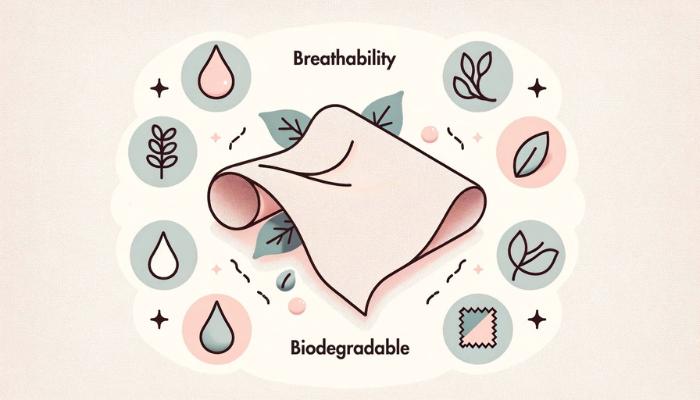
In the vast world of textiles, Lyocell stands out, not just for its sustainable production but also for the myriad of benefits it offers. Let’s explore what makes this fabric a favorite among eco-conscious consumers and fashion designers alike.
Blendability with Other Fabrics
- Versatility in Design: Lyocell’s natural ability to blend seamlessly with a variety of fabrics, from cotton to silk, opens up a world of design possibilities. Whether it’s a summer dress or a cozy winter scarf, Lyocell complements other materials, enhancing their properties and feel.
Moisture Absorption and Breathability
- Stay Dry and Comfortable: One of Lyocell’s standout features is its superior moisture-wicking ability. It can absorb moisture up to 50% more than cotton, ensuring you stay dry and comfortable.
- Natural Breathability: The fabric’s structure allows for optimal breathability, making it perfect for hot climates or those sweaty gym sessions.
Strength, Durability, and Skin-friendliness
- Built to Last: Don’t be fooled by its soft touch. Lyocell is robust and durable, holding its own against wear and tear. Whether it’s a frequently worn pair of jeans or bed linens, Lyocell products are built to last.
- Kind to Your Skin: With its smooth fiber surface, Lyocell feels incredibly soft against the skin. Its hypoallergenic properties make it suitable for those with sensitive skin, ensuring comfort with every wear.
Eco-friendly Production
- Sustainability at its Core: Beyond its production, Lyocell’s eco-friendliness extends to its very essence. The fabric is biodegradable, ensuring it returns to nature, leaving minimal environmental impact.
- Chemical-Free Promise: The production of Lyocell steers clear of harmful chemicals, ensuring the fabric remains pure and untainted.
In a nutshell, Lyocell is more than just a fabric; it’s a testament to how innovation and sustainability can come together to create something truly remarkable.
4. Diverse Applications of Lyocell
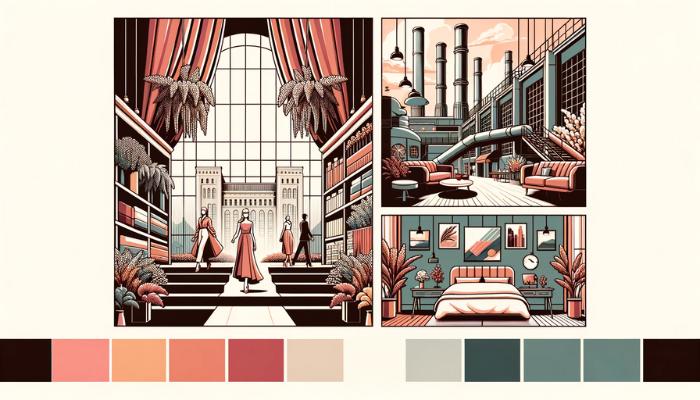
Lyocell, with its unique properties and eco-friendly nature, has found its way into a myriad of applications. From the fashion runway to the industrial floor, its versatility is evident. Let’s explore the diverse domains where Lyocell is making a mark.
Fashion Forward
- Dresses: The drape and softness of Lyocell make it a favorite for dresses. Its breathability ensures comfort, while its sheen adds a touch of elegance.
- Towels: Imagine wrapping yourself in a towel that’s not only soft but also super absorbent. That’s the magic of Lyocell towels.
- Underwear: Comfort is paramount when it comes to underwear. Lyocell’s moisture-wicking properties and smooth texture make it an ideal choice.
- Shirts: From casual tees to formal shirts, Lyocell brings a blend of comfort and style to the table.
Industrial Impact
- Conveyor Belts: The strength of Lyocell fibers makes them suitable for industrial applications like conveyor belts, where durability is crucial.
Medical Marvels
- Wound Dressing: The hypoallergenic and breathable nature of Lyocell makes it perfect for medical applications, especially in wound dressings where preventing infections is vital.
Beyond the Norm: Specialty Papers
- Eco-friendly Papers: In the realm of specialty papers, Lyocell stands out. Its biodegradability and sustainable production process make it a preferred choice for eco-conscious paper products.
From everyday wear to specialized industries, Lyocell’s presence is a testament to its unparalleled benefits and adaptability.
5. Comparing Lyocell with Similar Fabrics
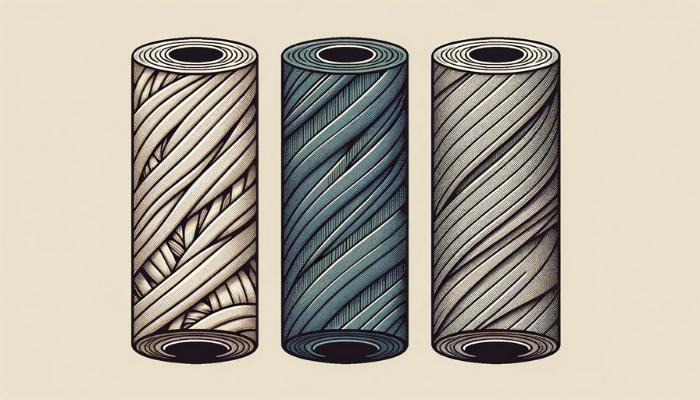
In the vast tapestry of textiles, Lyocell holds a unique position. But how does it stack up against other fabrics? Let’s dive into a comparative analysis to understand the nuances and distinctions.
Viscose Rayon vs. Lyocell
- Origin: Both originate from cellulose, but while Viscose often comes from various sources, Lyocell primarily uses sustainable tree sources.
- Production: Viscose’s production involves chemicals like carbon disulfide, which can be harmful. In contrast, Lyocell employs a non-toxic solvent in a closed-loop system, emphasizing sustainability.
- Strength: Lyocell boasts superior strength, especially when wet, compared to Viscose Rayon.
Modal Rayon vs. Lyocell
- Texture: Both fabrics are known for their softness, but Lyocell often feels smoother and more luxurious.
- Environmental Impact: While Modal Rayon is more eco-friendly than traditional rayon, Lyocell’s production is still more sustainable, especially with its closed-loop system.
- Durability: Lyocell edges out with its robust nature, ensuring longevity in products.
Lyocell vs. The Rest
- Polyester: A synthetic fabric, polyester doesn’t offer the breathability or moisture-wicking properties of Lyocell. Additionally, Lyocell is biodegradable, while polyester isn’t.
- Viscose & Rayon: As discussed, while they share similarities, Lyocell’s sustainable production and strength make it stand out.
- Cotton: A natural fabric like Lyocell, cotton is breathable and soft. However, Lyocell offers better moisture absorption and is often produced more sustainably.
The Distinction between Lyocell and Tencel
- Name Game: Tencel is a brand name for a type of Lyocell fiber produced by the company Lenzing AG. Think of it as the relationship between “facial tissue” and “Kleenex.”
- Quality: Tencel often undergoes rigorous quality checks and might have specific enhanced properties, but at its core, it’s still Lyocell.
- Environmental Standards: Tencel, being a branded product, often emphasizes its eco-friendly production and sources its raw materials from certified sustainable forests.
In the world of fabrics, understanding these subtle differences can guide informed choices, ensuring we opt for materials that align with our values and needs.
6. Environmental Impact of Lyocell
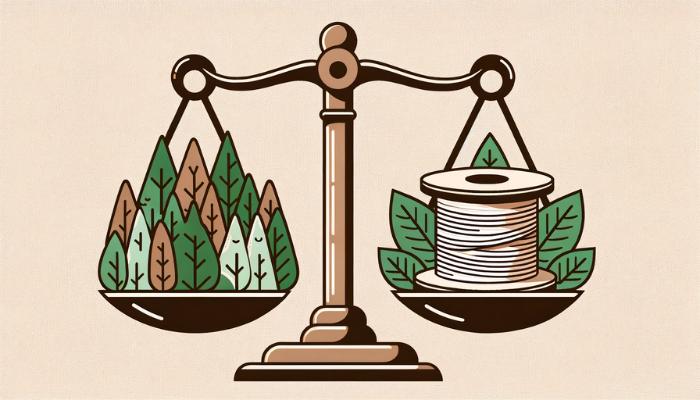
In an era where sustainability is more than just a buzzword, the textiles we choose play a pivotal role in shaping our environmental footprint.
Lyocell, with its green credentials, has emerged as a frontrunner in the eco-friendly fabric race. But what makes it so special, and are there any concerns we should be aware of?
The Sustainability Factor
Lyocell’s production process is a masterclass in sustainability. The closed-loop system ensures that nearly 99% of the non-toxic solvent used is recycled and reused. This not only conserves resources but also minimizes harmful emissions, making the entire process environmentally friendly.
Moreover, the fabric itself is biodegradable, ensuring that it returns to the earth, leaving minimal traces behind.
A Word on Tree Consumption
While Lyocell’s eco-credentials are impressive, there are concerns about tree consumption. After all, the fabric is derived from wood pulp. However, it’s essential to note that the majority of Lyocell production sources wood from sustainable tree farms. These farms are dedicated to ensuring a balance, where the rate of tree planting surpasses that of consumption.
Championing Sustainable Tree Farming
The heart of Lyocell’s environmental impact lies in sustainable tree farming. By prioritizing farms that adhere to responsible forestry practices, the fabric ensures a reduced carbon footprint. These farms not only focus on replenishing what they take but also maintain the biodiversity of the region, ensuring that the ecosystem thrives.
In conclusion, while no fabric is without its challenges, Lyocell’s commitment to sustainability and its proactive measures make it a top choice for the eco-conscious consumer.
7. Caring for Lyocell Fabrics
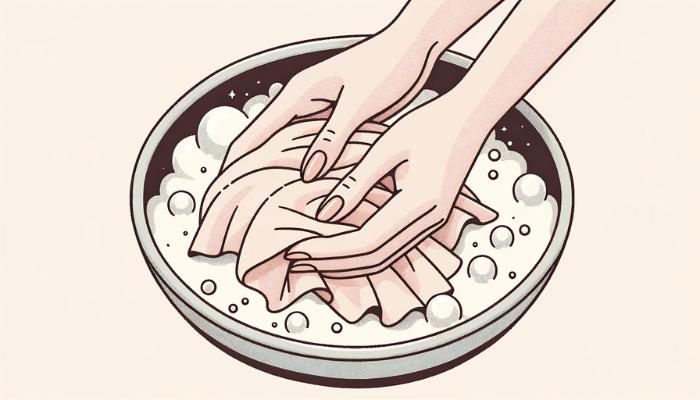
Lyocell, with its luxurious feel and eco-friendly credentials, is a favorite for many. But to ensure its longevity and maintain its pristine condition, proper care is paramount. Here’s a guide to keeping your Lyocell products in tip-top shape.
Washing: Hand vs. Machine
While Lyocell is robust, it appreciates a gentle touch. Handwashing in cold water with a mild detergent can help maintain its texture and color. However, if you’re pressed for time, machine washing on a gentle cycle is also an option. Just remember to turn the fabric inside out and use a gentle detergent.
Drying and Ironing
Lyocell dries best naturally. Avoid wringing it; instead, lay it flat or hang it to dry. If you’re in a hurry, tumble drying on a low setting works, but it’s not the preferred method. When it comes to ironing, a warm setting is sufficient. Ensure the iron doesn’t get too hot, as direct heat might scorch the fabric.
Special Care for Specific Products
Different Lyocell products might have unique care instructions. For instance, a Lyocell-blend dress might differ from pure Lyocell bed linens. Always check the care label. Some might even suggest “dry-clean only,” especially if they have other fabric components.
In essence, with a little care and attention, your Lyocell products can remain as good as new for years to come.
8. Conclusion: The Future of Lyocell in Sustainable Fashion
As the world pivots towards sustainability, the textile industry is no exception. The rising demand for eco-friendly fabrics has placed Lyocell in the limelight. Its blend of comfort, durability, and environmental consciousness makes it a sought-after choice for both consumers and designers. Leading brands, recognizing the fabric’s potential, are increasingly incorporating Lyocell into their collections, from everyday wear to high-end fashion.
But Lyocell’s journey is just beginning. Its sustainable production, coupled with its myriad of benefits, positions it as a catalyst for change in the textile world. As research advances and innovations emerge, the potential for Lyocell to revolutionize sustainable fashion is immense.
In a world yearning for green solutions, Lyocell stands tall, promising a future where fashion and sustainability walk hand in hand.
9. Frequently Asked Questions
Q. Is lyocell a good fabric?
A. Yes, Lyocell is an excellent fabric known for its softness, strength, and eco-friendly production process.
Q. What are the disadvantages of lyocell fabric?
A. While Lyocell boasts many benefits, it can be more expensive than other fabrics and may wrinkle easily. Additionally, improper care can lead to shrinkage.
Q. Which is better lyocell or cotton?
A. Both fabrics have their merits. Lyocell is more absorbent, eco-friendly, and often softer. Cotton is breathable and has been a staple for centuries. The choice depends on personal preference and the intended use.
Q. Is lyocell the same as polyester?
A. No, Lyocell is a natural, biodegradable fabric derived from wood pulp, while polyester is a synthetic, non-biodegradable material made from petroleum-based resources.
